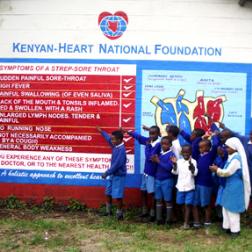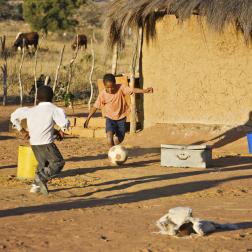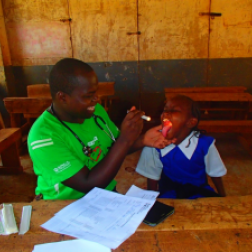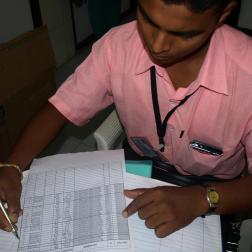RHD and non-communicable disease
The Global Action Plan on Non-communicable Disease and the emergence of post-MDG global health agenda offer opportunities to examine RHD as an NCD of poverty and a sentinel of health inequality. While nearly eliminated in wealthy populations, rheumatic heart disease still causes maternal mortality and kills or debilitates hundreds of thousands of children and youth in low-income settings. As they struggle to provide high-cost treatment for the disease in advanced stages, health systems in most low-income countries do not systematically implement low-cost measures of RHD prevention in primary care.
RHD, mothers and babies
Women with RHD are at risk of heart failure and arrhythmias during pregnancy. In late pregnancy blood volume increases by 30 – 50% and heart rate rises. During and after delivery blood pressure and cardiac output increase in association with contractions. These changes require considerable cardiovascular elasticity.
In women with RHD this capacity may be limited by established heart failure or blood flow restricted by scarred rheumatic heart valves. Signs and symptoms of this cardiac deterioration are easily confused with late pregnancy: breathlessness, fatigue and swelling (oedema) and soft heart murmurs. Undiagnosed, cardiovascular collapse can lead to maternal death.
There is good evidence that RHD is a significant contributor to maternal mortality around the world. Indirect obstetric deaths are caused by underlying medical conditions made worse by pregnancy. Indirect deaths account for 16.7% of maternal deaths in Africa and 12.5% in of maternal deaths in Asia.
Some women with RHD will become pregnant, others are diagnosed when they become symptomatic during pregnancy. Some women will be undiagnosed until they become acutely unwell during delivery.
Although all deliveries with maternal heart disease are high risk it may be possible to minimise this risk by:
- Diagnosing the RHD prior to delivery (and preferably prior to conception).
- Early antenatal care and planning for delivery.
- Delivery by in medical facilities equipped to manage high risk pregnancy.
- Access to contraception.
Strategies to improve integration with maternal and child care could include:
- Educating all women with RHD that all pregnancies/deliveries need close medical supervision, and providing tangible support for accessing medical care. Providing accurate and supportive education about RHD in pregnancy is very important; the social and cultural effects of having a condition which influences fertility may be significant.
- Developing a referral system for primary health workers and midwives to access echocardiography and specialist review for women with rheumatic heart disease.
- Include RF/RHD in routine antennal care, including medical history and cardiac auscultation.
- Provide education for midwives about symptoms of heart failure which can be easily confused with the symptoms of late pregnancy.
RHD and primary care
The foundation of primary health care is working at a community level, responding to a community’s needs and taking into account the aspirations of each segment of a community at the economic, social and cultural levels.
The general principles of community based programs transcend disease specific issues and focus on the needs of individuals and their families. RF and RHD are ideally suited to a primary care approach; early signs (sore throat, joint pain)are often identified by primary care clinicians. Secondary prophylaxis and much ongoing care can be safely provided by primary care staff which reduces costs and improves accessibility. Providing the majority of care through supported primary care clinicians can benefit consumers and the broader health system. A number of specific control program components can be delivered in the primary care setting:
Delivery of primary prophylaxis
Evaluating and treating sore throats is an important part of primary care and should be a core competency for front line health staff in most settings. Enhancing access to primary care is important for making primary care practical and affordable. For example, In New Zealand, 6 – 18 year olds from high risk communities are offered ‘walk-in’ consultations with registered nurses for sore throat evaluation and treatment.
Diagnosis of suspected RF
Primary care staff have a critical role in identifying suspected cases of RF. Secondary prophylaxis can only be initiated for people who present for care and are receive the correct diagnosis of RF. Diagnosis relies on accurate use of the Jones Criteria. In endemic settings primary care staff need sufficient training to recognise possible cases, and refer for them definitive diagnosis.
Delivery of secondary prophylaxis
Although register based programs are helpful for ensuring consistency of BPG administration it may be possible to shift some secondary prophylaxis to primary care practitioners – particularly in rural or remote locations. Primary care systems may need adjustment to make this possible.. For example, existing computer, triage or administrative systems can be adapted to include diagnostic codes and follow up recalls for RF and RHD.
Education and primordial prevention
Primary care staff are uniquely positioned to know local families, identify who is at risk for RF and RHD, to provide education about overcrowding, advocate for families and provide targeted interventions where they are needed most. The important and time consuming role of primary care in prevention, advocacy and education should not be overlooked amidst the delivery of clinical services.
RHD Control in schools
School age children are at greatest risk of RF, making schools an important component of disease control efforts.
Teachers and educators have an important role in identifying children with a sore throat, symptoms of RF (particularly joint pain and chorea) and children with heart failure. Prevention programs, care delivery and specialist outreach may also be integrated into school programs. Administrative or logistic support from schools to record secondary prophylaxis adherence, notify programs of transfers or new students may be possible.
There are many examples of integrating RHD control in schools around the world:
- In Cuba the education system was a key component of the plan developed to implement a control program and included a representative of the Ministry of Education. Education personnel received training in RF and RHD.
- In South Africa school health nurses are being trained to provide antibiotics for children with sore throats.151
- In New Zealand diagnosis and management of sore throats and skin infections is integrated into schools in high risk communities.
- In India the Rupnaga District Project is training school teachers to identify suspected cases of RF.
- In Samoa collaboration with the Ministry of Education, Sports and Culture was a significant aspect of a pilot program implemented in selected schools.
"The school occupies a unique position in relation to rheumatic fever control.”
- American Academy of Pediatrics, 1948
Education and awareness for school students
School-based education is an effective strategy to target young people most at risk of RF and RHD. Education can be incorporated into regular health education classes. This may include a range of health and hygiene messages; hand hygiene, healthy eating and tobacco control education. Health messaging can occur alongside other education initiatives. In Kenya, for example, school children were taught about RF/RHD in conjunction with healthy diet education.
Teaching should also occur alongside events dedicated to RHD control, including echo screening or sore throat swabbing programs.
In the New Zealand, setting presentations by health care professionals were more effective at communicating with students than either paper handouts or lessons from a primary school teacher.However, engaging teachers with the program appears to be important for the transmission of knowledge from teachers to students.
In Sudan, teachers receive a manual about RHD, and hundreds have seen a video about RHD as part of their teacher training. Part of Cuba’s successful RF/RHD control program was school-based education of pupils, teachers and parents on the importance of prevention, symptom recognition and adherence with secondary prophylaxis. In Nepal, students have written poems, performed skits and sung songs about RF/RHD to raise awareness. However, this strategy is limited by school attendance – in settings where few children attend or complete school this approach may fail to delivery education to those in greatest need.
Disease notification
A notifiable disease is any disease required by law to be notified to the government or other health authority. Diseases to be notified to WHO are outlined in the International Health Regulations but most countries have their own list of nationally notifiable diseases.156 Making a disease legally ‘notifiable’ by doctors and health professionals allows for intervention to control the spread of highly infectious diseases such as influenza, poliomyelitis or yellow fever. In less infectious conditions it improves information about the burden and distribution of disease.
In endemic settings RF – and potentially the first diagnosis of RHD – meet the criteria to be considered notifiable disease.
|
A recognisable disease |
RF can be diagnosed by the modified Jones criteria (see Annex A) though a different case definition may be used to trigger notifications. |
|
A preventable disease |
RF appears to be preventable at a population level by changing living circumstances. High quality secondary prophylaxis can be disease altering following an episode of RF, prompting calls for RF to be made a notifiable disease. |
|
There must be the potential for action |
For individuals with RF, notification can be linked to a register based program which provides secondary prophylaxis and prevents recurrences of RF. |
|
There must be an identified population or sub-population targets |
Young people at greatest risk of RF often come from low resource or vulnerable communities. |
|
Notified data should be usable |
RF notifications offer an opportunity to understand the distribution and burden of disease, plan interventions and monitor outcomes. |
RF has been made notifiable in many places: New Zealand, Australia, Fiji, South Africa, New Caledonia, Tuvalu, Kiribati and the Solomon Islands.
In South Africa RF and the first diagnosis of RHD were made notifiable in 1989. However, by 1992 the initial diagnosis of RHD had been removed from the notifiable disease list. Although amended, there appears to be significant under reporting of RF notifications. Of concern, nationally reported figures in this study implied a decreasing burden of RF, despite a consensus opinion by cardiologists of an ‘RF Epidemic’. This illustrates the risk of incompletely implemented RF notifications.
Case definitions
Many infectious notifiable conditions can be identified from positive laboratory tests (direct laboratory notification). There is no blood test for RF or RHD, so cases must be diagaosed and notified by clinicians. A strict case definition and accurate clinical diagnosis are needed. Clinicians often have considerable demands on their time and may be unfamiliar with reporting requirements. Significant underreporting is common. Clear guidelines are helpful for communicating and disseminating case definitions and pathways for reporting. The New Zealand ‘Communicable Diseases Control Manual’ is a good example of this approach – the RF chapter includes: case definition, case classification, notification procedure, case management and contact management.
Closing the feedback loop
One of the barriers to clinicians reporting RF or RHD can be a perception that the data is endlessly gathered but not used to make changes. Reporting information and action back to clinicians may be helpful to demonstrate that reports are being collated and acted upon. Routine publication of notifiable disease surveillance is standard in some parts of the world, for example via the Pacific Public Health Surveillance Network.
In countries without strong notifiable disease programs, clinicians with an interest in RF/RHD may work with other potentially notifiable diseases (for example: tuberculosis, leprosy, dengue and many others) to develop reporting systems.
Access to cardiac surgery
The suffering of people with severe RHD provokes a strong humanitarian drive for clinicians and communities to find ways of accessing surgical interventions. Few endemic settings have access to local cardiac surgical services; humanitarian cardiac surgery visits or medical evacuation programmes are a more common model of service delivery. Even when national or regional services exist, they are often geographically remote from the most endemic communities.
In low resource settings cardiac surgery programmes tend to be highly visible. The immediacy, visible results and powerful human stories surrounding surgery, often attract funding, media attention and community support. The profile and considerable expense of tertiary care has prompted legitimate concerns that surgical services may divert funds from cost effective register based programmes. However, incorporating interventional services into RHD control
programmes has a number of potential benefits:
- Maximise the benefit of surgery by ensuring the most suitable candidates receive intervention.
- Strengthen capacity for post-operative follow up, including the continuation of secondary prophylaxis and anticoagulation.
- Strengthen referral systems and handover between different levels of the health system.
- Knowledge transfer between local health staff national/regional/visiting/international staff about local practices, health services and approaches.
- Support training and capacity development.
- Humanitarian cardiac surgical programs typically have far greater fundraising capacity than local, register based RHD control programmes. Working together may make it possible to distribute these resources more equitably to support both treatment and intervention.





